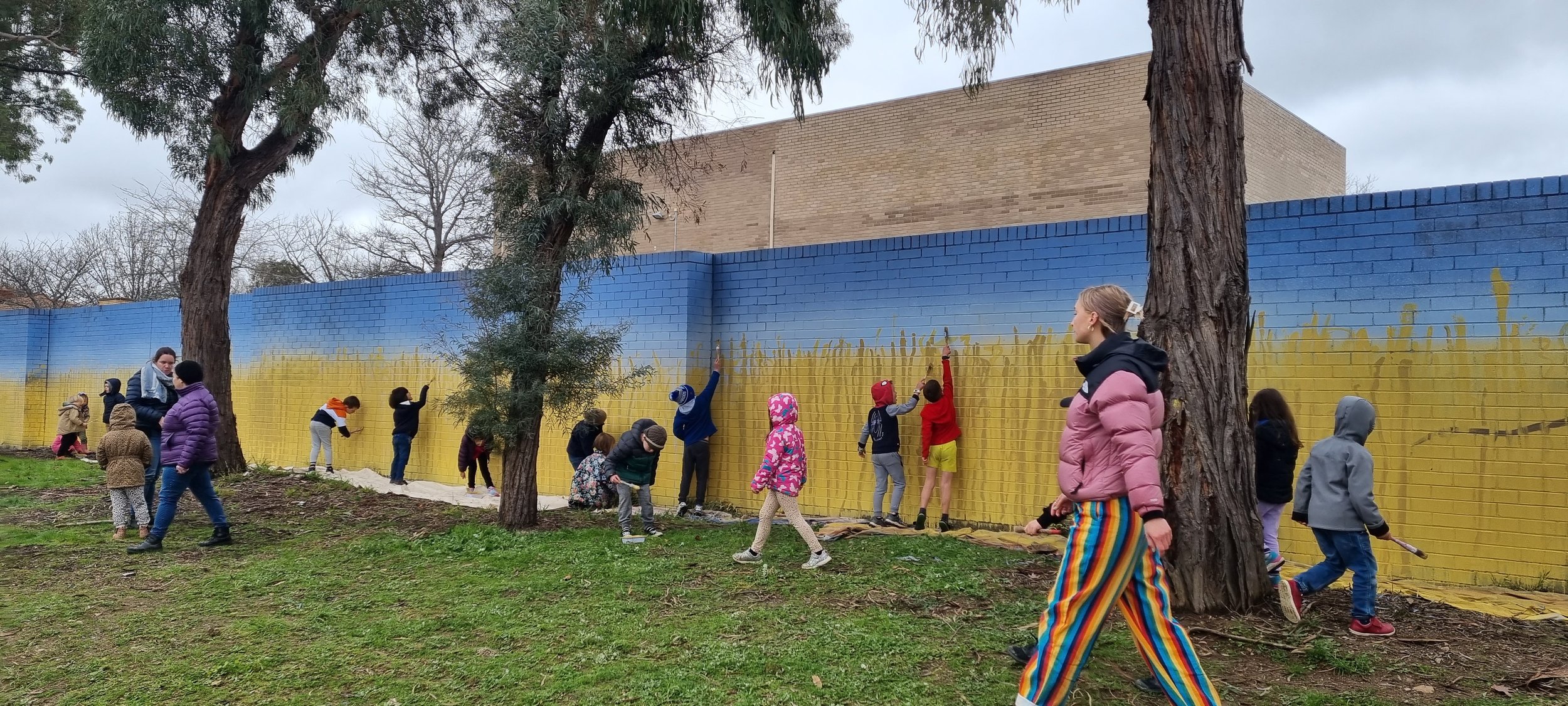Blue Gum Community School Mural at Hackett Shops, 2021. Australian Capital Territory.
Photographs of the Hackett Shops mural with Blue Gum Community School, 2021. Photographed by Faith Kerehona.
Co-create would be regarded the most exciting phase of the project. Over a two-week period, 160 students at the school from K-16 participated in painting the mural. Each group had between 1-2 hours to paint in their art class groups of up to 30 students. Activities were adapted depending on the age and ability levels of the students. For most of the students, apart from the very youngest, they chose from photographs the type of flora or fauna they wanted to paint and were given special elements of the walls to paint. On the wall we painted gum trees, and the students could also write inside these leaves why they think conservation is important.
Peta Bulling at Lawson Grasslands, 2021.
Rainer Rehwinkel at Lawson Grasslands, 2021.
Students brainstorming the importance of Conservation in the Artyology room at Blue Gum Community School, 2021. Photographed by Faith Kerehona.
Written and drawn responses from the students as to why Conservation is important, 2021. Photographed by Faith Kerehona.
Photographs of the students painting the mural, 2021. Photographed by Faith Kerehona.
“Faith was an amazing artist to work with; she was so giving to the students, sharing her skills and allowing our students to have choice in what species they painted and the location across the three walls. The students learnt many new techniques creating their representations of Golden Sun Moths, legless lizards. Most had never painted on this scale before. We look forward to celebrating the mural with the Hackett community.”
This project’s aim was to raise awareness about a critically endangered habitat and promote discussions surrounding the importance of conservation with a local community school.
Context
Blue Gum Community School is a small, secular, community based independent school offering education for 0–16-year old’s. It opened in 1998 and is located in Canberra, Australia. The school values the Australian context, environment and inheritance whilst celebrating the importance of educators in diverse cultures and contexts. Blue Gum adopts a personalised, strengths-based approach to education where the student’s individual interests and passions support the classes exploration of research.
The location of the school is in a central part of Canberra, Hackett, which is a leafy and established suburb of Canberra near the base of Mount Majura and Mount Ainslie. Mikki, the school’s art teacher, shared that the students frequently have excursions or hold their classes in the surrounding mountains and were very passionate about the environment and ‘learning through their feet’. The school itself is unique, with permanent art projects by the students adorning the gardens, foyer, and interior spaces. There are no fences around the school, even for the youngest students, and the playgrounds consist of native stone and natural wood, imitating the surrounding bushland.
The first stage of this project was to Inform. This involved establishing an initial contact with the school, the funding body (TCCS) and to provide some preliminary quoting. In this case, the school had reached out to Lisa Petheram, the Graffiti Coordinator in Canberra, to try to get in contact with an artist to provide a workshop/art project centred around Ecology and Native wildlife. This project utilised a large, 40m x 3m wall adjacent to the rear of the Hackett Shops, and engaged the whole school in the mural project. This meant 160 students painted this wall!
The next stage of CEP is to Consult. For this stage Faith Kerehona reached out to Peta Bulling, who is a Campaigner from the Conservation Council ACT. She is an Environmental Scientist and graduated Law Honours student at ANU. We discussed a campaign she is involved in to protect Lawson Grasslands, a critically endangered grassland habitat in Canberra, from housing development from Defence Housing Australia.
It was then proposed to theme the mural around the Lawson Grassland habitat and the Conservation Council was invited to engage with the project as a form of public education of the environment. They were enthusiastic to participate. We then met with Rainer Rehwinkel, a Grassland Ecologist and Senior Threatened Species Officer at the NSW Office of Environment and Heritage, who provided us a tour of Lawson Grasslands and the species which inhabit it.
Educate is the third stage in CEP, and its function is to familiarise participants with the intentionality and function of the mural, the WHS processes of painting and to provide an opportunity for discussion and workshopping before we paint the wall itself.
In this project, Peta Bulling conducted a presentation with the students (in their familiar ‘art class’ age groups) about Lawson Grasslands, why it’s worth protecting, and some of the species that inhabit the grasslands. We then ran a discussion workshop with the students about why conservation is important, working in small groups to write and draw our relationship with the environment before sharing as a large group. The students were inducted to the safety processes in the project, so they were informed before the project commencing. This stage is pivotal in contextualising who I am, what the project is about, and why it’s important. The plan for the mural was to paint the habitat of Lawson Grasslands, with each student having the opportunity to paint their own wildlife, flora, or fauna, on the wall. We painted the mural around 2 weeks later, and in this time, Mikki allowed the students to independently research the species that inhabit Lawson Grasslands and to practice painting and drawing them in their class time.
The last stage of the CEP process is Empowerment, and this is largely gained through the participants having agency, freedom, and offered modes of expression through the process of creating the mural. By investigating a topic that was important to the students, such as the environment, and then finding a local case study which would benefit from education and activism, the students can feel empowered to share their perspectives and to advocate for the issue. By understanding the importance of conservation, the students expressed their passion for the environment in a public space near their school, proving that their perspectives and expressions are valued and appreciated by the wider community. This mural became a point of pride and responsibility to the students, who were so excited by the achievement of painting something so large and collaboratively as a school. Many students walked past it with their parents who picked them up and showed them the animal they had painted and what they learnt about it.
Community Engagement Process (CEP) for Blue Gum Community School Mural
Adapted from the IAP2 Spectrum of Public Participation.
Photographs of the complete mural, 2021. Photographed by Faith Kerehona.

































